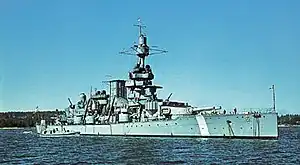 | |
| History | |
|---|---|
| Name | Sverige |
| Namesake | Sweden |
| Builder | Götaverken, Gothenburg |
| Laid down | 12 December 1912 |
| Launched | 3 May 1915 |
| Commissioned | 14 May 1917 |
| Decommissioned | 30 January 1953 |
| Fate | Scrapped 1958 |
| General characteristics | |
| Class and type | Sverige-class coastal defence ship |
| Displacement |
|
| Length |
|
| Beam | 18.63 m (61 ft 1 in) |
| Draught | 6.25 m (20 ft 6 in) |
| Propulsion |
|
| Speed | 22.5 kn (41.7 km/h; 25.9 mph) |
| Range | 2,720 nmi (5,040 km; 3,130 mi) at 14 kn (26 km/h; 16 mph) |
| Complement |
|
| Armament |
|
| Armour |
|
HSwMS Sverige was a Sverige-class coastal defence ship (Pansarskepp) commissioned by Sweden during the last year of the First World War. The ship cost approximately 12 million kronor, a sum raised entirely by public donations. The fundraising was done because of the Karl Staaff government's reluctance to spend money on a new battleship. In addition to its impressive cost, the ship also had a significant impact on the Swedish Navy and its capabilities.
Background
Sweden was not immune from the naval arms race in the early 20th century. After dissolving the union with Norway in 1905, the situation was tense with the Russian Empire in the east, Germany south of the Baltic Sea, and Norway, traditionally being an Anglophile country, to the west. In 1911, battle-ready units from the Royal Navy and the Imperial German Navy cruised around in the North Sea. Due to the perilous atmosphere brought about by these tensions, and as the latest Swedish coastal battleship Oscar II was a typical pre-dreadnought ship (with two 8-inch (203 mm) guns and a maximum speed of 17.8 knots (33.0 km/h; 20.5 mph)), the need for a new class of ships was pressing. Seaworthiness, armament, armour and speed, all had to be improved according to the multiple new technologies that had arrived with the naval arms race that followed the launch of the British HMS Dreadnought. In 1911, the parliament voted (with a small majority) funds for the building of the new vessel, known as the F-boat, after the alternative that was chosen from various options (A, B, C, D, D1, D2, E, E1, E2 and F, varying in size from 4,800 to 7,500 metric tons and with armaments and speed in various arrangements accordingly). The postponement of funding for the HMS Sverige by Prime Minister Karl Staaff had a significant impact on the "Pansarbåtinsamlingen" fundraising campaign. The campaign, which had aimed to raise 12 million Kronor for the ship, was put on hold as a result of the political uncertainty. Despite initial political uncertainty, the fundraising campaign for the HMS Sverige was successful, thanks to the support of King Gustav V. The campaign raised 15 million Kronor in just over three months, an impressive achievement. The new government accepted the money and let the contract for the ship, which was named Sverige for the people who had paid for it.[1]
After the outbreak of World War I, two more ships were ordered which had a slightly changed appearance, the two bearing the names of the King and Queen of Sweden.
Note that while the ship is listed as a battleship in Jane's Fighting Ships, 1938 edition, technically it is a coastal defence ship, a class which was commonly used in Nordic countries. The navies of Finland, Norway, and Denmark made use of similar ships. However, the Swedish Navy used the Sverige-class armored warships as the core of battle groups in the same manner as other navies used battleships.
Captains
- 1917–1918: Fredrik Riben
- 1926–1927: Gunnar Bjurner
- 1940–1940: Alarik Wachtmeister
- 1940–1941: Erik Anderberg
- 1945–1946: Henning Hammargren
Notes
- ↑ Warship Magazine - 1999
Bibliography
- Harris, Daniel G. (1992). "The Sverige Class Coastal Defense Ships". In Gardiner, Robert (ed.). Warship 1992. London: Naval Institute Press. pp. 80–98. ISBN 0-85177-603-5.
- Sundberg, Ulf (2018). "The Armoured Ship Sverige (1915)". In Taylor, Bruce (ed.). The World of the Battleship: The Lives and Careers of Twenty-One Capital Ships of the World's Navies, 1880–1990. Barnsley: Seaforth Publishing. ISBN 978-0870219061.